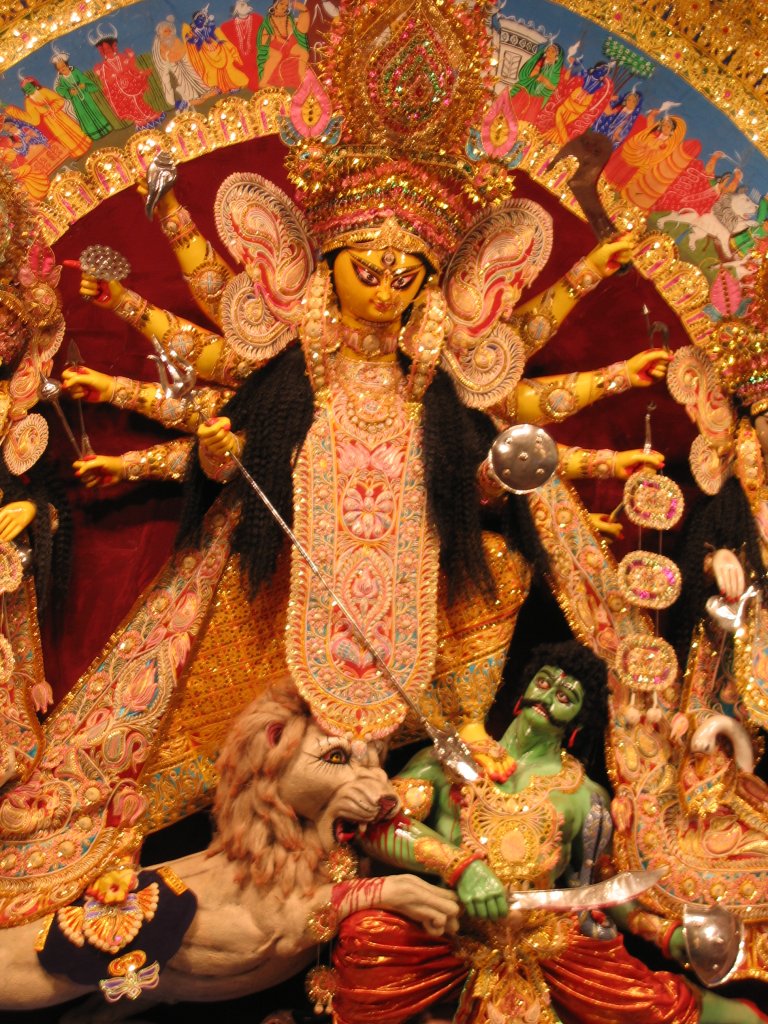|
Panthoibi
Panthoibi (, ), also known as , is a goddess associated with civilization, courage, fertility, handicraft, love, victory, warfare and wisdom in the mythology and religion of Ancient Kangleipak (early Manipur). She is a consort of the God Nongpok Ningthou. She is considered to be one of the divine incarnations of Leimarel Sidabi and is also identified as a form of Goddess Nongthang Leima. She is worshipped mainly by the Meitei people in Manipur, Assam, Tripura, Bangladesh and Myanmar. The personality of Panthoibi and other Meitei goddesses like Emoinu and Phouoibi depict as well as influence the courage, independence, righteousness and social honour of Meitei women. History According to the ''Panthoibi Khongul'', the worship of goddess Panthoibi began in the era of the Khaba dynasty. In 1100 AD, the Loyumba Shinyen mentions the Heishnam clan's service to goddess Panthoibi. The text addresses her as the most adored Meetei goddess. In the 17th century, Panthoibi appeare ... [...More Info...] [...Related Items...] OR: [Wikipedia] [Google] [Baidu] [Amazon] |
Panthoibi Khonggul
Panthoibi (, ), also known as , is a goddess associated with civilization, courage, fertility, handicraft, love, victory, warfare and wisdom in the mythology and religion of Ancient Kangleipak (early Manipur). She is a consort of the God Nongpok Ningthou. She is considered to be one of the divine incarnations of Leimarel Sidabi and is also identified as a form of Goddess Nongthang Leima. She is worshipped mainly by the Meitei people in Manipur, Assam, Tripura, Bangladesh and Myanmar. The personality of Panthoibi and other Meitei goddesses like Emoinu and Phouoibi depict as well as influence the courage, independence, righteousness and social honour of Meitei women. History According to the ''Panthoibi Khongul'', the worship of goddess Panthoibi began in the era of the Khaba dynasty. In 1100 AD, the Loyumba Shinyen mentions the Heishnam clan's service to goddess Panthoibi. The text addresses her as the most adored Meetei goddess. In the 17th century, Panthoibi appeared a ... [...More Info...] [...Related Items...] OR: [Wikipedia] [Google] [Baidu] [Amazon] |
Nongpok Ningthou
Nongpok Ningthou , also known as the Sovereign of the East or King of the East, is a deity in Sanamahism, the indigenous religion of Manipur. He is the ruling guardian deity of the eastern direction. Legend says Nongpok Ningthou and his consort Panthoibi were united in the Nongmaiching Ching mountains. Later, they were worshipped as the civilization giving deities in Sanamahism, Meitei religion. Nongpok Ningthou is one of the principal Umang Lais. He was originally known as ''Langmai Ningthou'' (Lord of the Langmai people). History The Nongmaiching Hill (also known as Selloi Langmai Hills) was the ancestral territory of the Selloi Langmai people. This zone has the strongest worship of God Langmai Ningthou (Nongpok Ningthou). According to the Nongmaiching Chingkoipa (AKA Nongmaijing Chingoiba) text, the mountain in the east and beyond the rivers (Imphal R., Iril R. and Kongba R.) is the abode of God Keinou Chingsompa (another name of Nongpok Ningthou). According to the :simp ... [...More Info...] [...Related Items...] OR: [Wikipedia] [Google] [Baidu] [Amazon] |
Umang Lai
Umang Lai () refers to a group of ancient Meitei deities of the traditional Meitei religion (Sanamahism) who are worshipped as the local guardians of particular areas, especially sacred groves. These deities are worshipped annually. Their Sacred groves of India, sacred groves are preserved by the Meitei people since ancient times, mostly in the Northeast Indian state of Manipur. Their pleasing ceremony is always celebrated every year through a music and dance festival, known as Lai Haraoba. There are more than 365 Umang Lai shrines in Manipur state alone. They are integral parts of Meitei mythology, Meitei folklore, folklore and Meitei religion, religion. The cults of these deities vary from community to community. Etymology "Umang" means "forest" and "Lai" means "deity" in Meitei language (also known as Manipuri language). List of deities Umang Lai sacred groves are widely distributed in Imphal East, Imphal West, Thoubal, Kakching and Bishnupur district, Bishnupur dist ... [...More Info...] [...Related Items...] OR: [Wikipedia] [Google] [Baidu] [Amazon] |
Nongmaiching Hill
Nongmaiching Hill or Nongmaijing Hill, also known as the Selloi Langmai Ching, is a hill in the Imphal Valley in Manipur, India. It rises to the east of the Imphal City with a peak at an elevation of above sea level. It is a holy pilgrimage site for the Meitei people. In Meitei mythology and religion (Sanamahism), it is a sacred mountain and the abode of God Nongpok Ningthou and Goddess Panthoibi. In Meitei folklore, the Nongmaiching is described as the hill that produces ''"the seven days of a week"''. Etymology According to many scholars including Thomas Callan Hodson of the Cambridge University, the Meitei language term "Nongmaiching" () is derived from the terms, "nong" (), "mai" () and "ching" (). Nong means sun or rain, mai means face or "in front of", and ching means hill or mountain. So, "Nongmaiching" means "the hill that fronts the rain or sun". According to Tarak Chandra Das of the Calcutta University, the term "Nongmaiching" is translated as "the hi ... [...More Info...] [...Related Items...] OR: [Wikipedia] [Google] [Baidu] [Amazon] |
Numit Kappa
Numit Kappa is an ancient Meitei language mythological epic literary work. The work is believed to be written around or before 33 AD. It is written in the form of partial poetry and partial prose. The epic work is still considered to be the oldest known epic account in Meitei literature. Synopsis In the epic, there are two Sun Gods, who brighten the world simultaneously. One was to be slain in order to create the night. The hero, ''Khwai Nungjeng Piba'' was an expert archer, who shot ''Taothuireng'', one of the two Suns in the sky. Two survived out of the five sons of the Celestial Goddess "O my Mother, O Mother of the Sun who is the Father of the world, O Mother of all the Gods. She who was the Mother of the World gave birth one day to three sons. The first-born son was destroyed like withered paddy, and became like old dry paddy, and entered into the earth, and became even as the ant heaps. Thereupon the paddy and the great paddy were turned into Morasi and Ir ... [...More Info...] [...Related Items...] OR: [Wikipedia] [Google] [Baidu] [Amazon] |
Meitei Mythology
Meitei mythology (or Manipuri mythology) () is a collection of myths, belonging to the religious and cultural traditions of the Meitei people, the predominant ethnic group of Manipur. It is associated with traditional Meitei religion of Sanamahism. Meitei myths explain various natural phenomena, how human civilization developed, and the reasons of many events.Devi, Dr Yumlembam Gopi. Glimpses of Manipuri Culture. ISBN 978-0-359-72919-7. Textual sources Mythical narration plays an integral role in nearly every genre of Meitei literature (Manipuri literature). Some of the best known literary sources are: Mythical beings Mythical beings include gods, goddesses, mythical creatures and many others. References Asian mythology Meitei mythology Sino-Tibetan mythology Indian religions Culture of India Culture of Manipur {{Meiteimyth navbox long ... [...More Info...] [...Related Items...] OR: [Wikipedia] [Google] [Baidu] [Amazon] |
Manipuri Mythology
Meitei mythology (or Manipuri mythology) () is a collection of myths, belonging to the religious and cultural traditions of the Meitei people, the predominant ethnic group of Manipur Manipur () is a state in northeastern India with Imphal as its capital. It borders the Indian states of Assam to the west, Mizoram to the south, and Nagaland to the north and shares the international border with Myanmar, specifically t .... It is associated with traditional Meitei religion of Sanamahism. Meitei myths explain various natural phenomena, how human civilization developed, and the reasons of many events.Devi, Dr Yumlembam Gopi. Glimpses of Manipuri Culture. ISBN 978-0-359-72919-7. Textual sources Mythical narration plays an integral role in nearly every genre of Meitei literature ( Manipuri literature). Some of the best known literary sources are: Mythical beings Mythical beings include gods, goddesses, mythical creatures and many others. References Asian m ... [...More Info...] [...Related Items...] OR: [Wikipedia] [Google] [Baidu] [Amazon] |
Sanamahism
Sanamahism , also known as Meiteism , or Lainingthouism is an ethnic religion of the Meitei people of Manipur, in Northeast India. It is a polytheistic religion and is named after Lainingthou Sanamahi, one of the most important deities of the Meitei faith. Sanamahi is the eldest son of the supreme god Sidaba Mapu and the supreme goddess Leimarel Sidabi. Traditionally every Meitei household, irrespective of the religion, worships Sanamahi and Leimarel Sidabi. Sanamahism does not have a religious head but has a body, the Maru Loishang, that oversees the main religious activities and governs all affairs of the religion, including the conduct of priest and priestess. The Maru Loishang also acts a court for religious disputes. There are three main departments under the Manu Loishang, namely, the Amaiba Loishang, the Pena Asheiba Loishang, and the Amaibi Loishang. These departments have existed since the reign of King Meidingu Hongnemyoi Khunjao Naothingkhong of Manipur in 662 ... [...More Info...] [...Related Items...] OR: [Wikipedia] [Google] [Baidu] [Amazon] |
Durga
Durga (, ) is a major Hindu goddess, worshipped as a principal aspect of the mother goddess Mahadevi. She is associated with protection, strength, motherhood, destruction, and wars. Durga's legend centres around combating evils and demonic forces that threaten peace, prosperity, and dharma, representing the power of good over evil. Durga is believed to unleash her divine wrath against the wicked for the liberation of the oppressed, and entails destruction to empower creation. Durga is seen as a motherly figure and often depicted as a beautiful woman, riding a lion or tiger, with many arms each carrying a weapon and often defeating demons. She is widely worshipped by the followers of the goddess-centric sect, Shaktism, and has importance in other denominations like Shaivism and Vaishnavism. The most important texts of Shaktism, Devi Mahatmya and Devi Bhagavata Purana, revere Devi (the Goddess) as the primordial creator of the universe and the Brahman (ultimate truth and reali ... [...More Info...] [...Related Items...] OR: [Wikipedia] [Google] [Baidu] [Amazon] |
Minerva
Minerva (; ; ) is the Roman goddess of wisdom, justice, law, victory, and the sponsor of arts, trade, and strategy. She is also a goddess of warfare, though with a focus on strategic warfare, rather than the violence of gods such as Mars. Beginning in the second century BC, the Romans equated her with the Greek goddess Athena.''Larousse Desk Reference Encyclopedia'', Book People, Haydock, 1995, p. 215. Minerva is one of the three Roman deities in the Capitoline Triad, along with Jupiter and Juno. Minerva is a virgin goddess. Her domain includes music, poetry, medicine, wisdom, commerce, weaving, and the crafts. Minerva is often depicted with her sacred creature, an owl usually named the " owl of Minerva" which symbolised her association with wisdom and knowledge, as well as, less frequently, the snake and the olive tree. Minerva is commonly depicted as tall with an athletic and muscular build. She is often wearing armour and carrying a spear. As an important Roman g ... [...More Info...] [...Related Items...] OR: [Wikipedia] [Google] [Baidu] [Amazon] |




